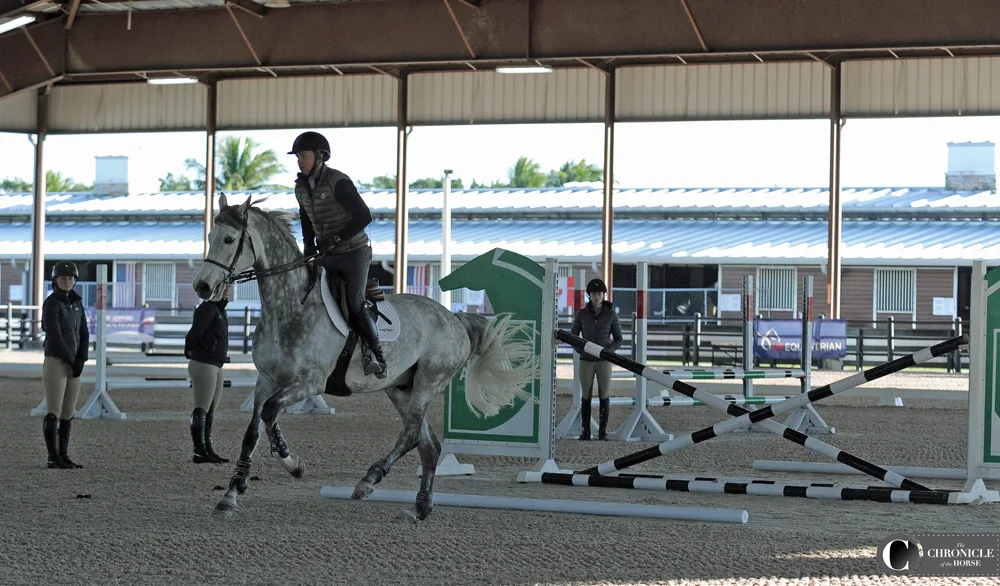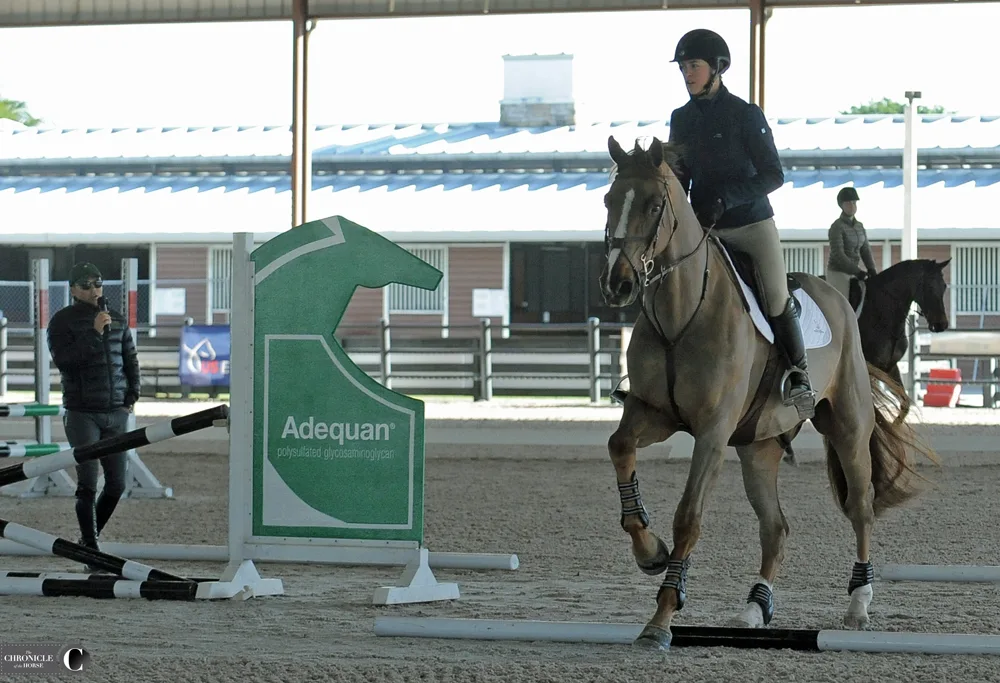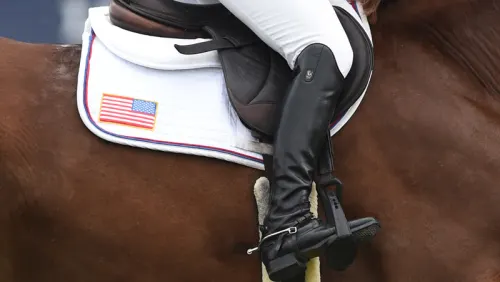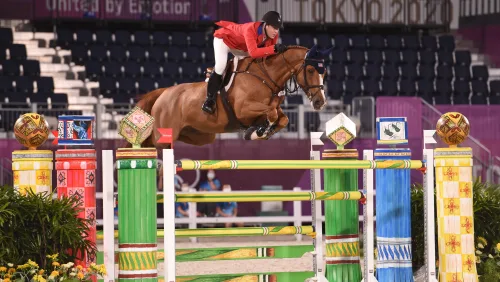Wellington, Fla.—Jan. 6
He became the world’s No. 1-ranked show jumping rider by winning over 1.60-meter tracks in the show ring, but for the most part Kent Farrington trains over fences just a quarter of that height.
“I’m not embarrassed to jump tiny jumps,” Farrington told riders and auditors at Friday’s session of the George H. Morris Horsemastership Training Session. “Even on a new horse with plenty of experience. I’ve bought grand prix horses and taken then in a 3′ or 3’3″ class our first time in the ring.”

Kent Farrington schools his horse Baltic Star II over a simple crossrail exercise. Photo by Ann Glavan.
Farrington sees no sense in jumping massive fences when he can accomplish the same goals over poles and gymnastics, which was the focus of both his demonstration ride and his lessons at the clinic.
“You can feel the same problems you’re going to get over fences on poles on the ground, with rails and very small cavelettis,” Farrington said. “I’m not just going to pop over fences for no reason; it’s never random jumping, I always have a plan.”
While Farrington does often have classically correct equitation and most of his excercises rode very smoothly, he emphasized that having a pretty go around the gymnastics is not the point.
“I’m not schooling him in gymnastics to get him better at gymnastics, I want him to be better in the show ring,” Farrington said. “It’s OK if this isn’t smooth and beautiful or if it doesn’t look like an equitation round.”
Farrington kicked off the morning working his horse, Baltic Star II, over the gymnastic exercises he set up. All of the related distances between rails and fences were one stride apart with take-off and landing rails added in throughout the course.
Farrington began by simply cantering a one-stride of ground poles each direction.
ADVERTISEMENT
“I’m going for a nice quiet distance here,” Farrington explained. After cantering the poles Farrington pulled up to the walk to change direction and canter them again. “So much of our showing is at speed, so in my schooling at home I’m always bringing the horse back and keeping everything really calm,” Farrington said.
Bit by bit Farrington added in parts of his gymnastics course—a crossrail with take-off and landing rails, a triple combination of verticals with landing rails, a triple of oxers, and two oxers set off of short turns on the end of the arena. After each element, Farrington would turn the opposite direction a rider would typically go after the fence.
“He anticipates going to the right and that’s why it’s important I’m rolling back to the left,” Farrington explained. “I’m trying to reprogram my horse a bit.”
Farrington encouraged riders to get out of their comfort zone and focus on their weaknesses. For example, he explained his horse Baltic Star was weak on the right lead, so he moved the take-off rail out slightly on an oxer to make the horse to really stretch and jump out of its right lead.

Kent Farrington (left) coaches rider McKayla Langmeier through a ground pole exercise. Photo by Ann Glavan.
“I’m always trying to train what’s uncomfortable, what the weakness is, both my own and the horses,” Farrington said. “I’m never afraid to do that. Even here in this demonstration I’m trying to use this opportunity to make my horse better and stronger.”
Between his riding demonstration and the riders’ lessons, Farrington took the time to answer audience questions and share his thoughts on a number of different topics.
Advice on schooling a horse’s problem areas:
“I think it’s important when you’re working on a weakness that you don’t totally ignore their strength. If I’m trying to work on a weakness, I want to incorporate that work into an exercise they already know and are confident in. If I feel the horse struggling too much, I go back and have him be confident and I wait for another day. I’m not on a clock for anything when I’m training a horse; if I just jump a crosspole once the way I like it, that’s what I do. If I don’t get past the poles, I don’t get past the poles.”
What would you do with a young horse who roots, gets heavy and pulls down in the downward transition?
ADVERTISEMENT
“I would put that horse on a lunge line or work him with some side reins so he’s not always battling the rider. Part of the issue could be if the horse is young he could just not be strong enough, so you could do less demanding work and try to get a tiny improvement and let the horse finish on a positive note. If I put him on a lunge line and he does that transition better I let him be done, even if it’s only 10, 15 minutes. If the horse gets tired and the work goes on and on and on, he’s going to resent the work.”
What does a typical schedule for your horse’s week look like?
“I would say I do gymnastic work once a week and small course work once a week and them I’m doing two days of flat work, one day of poles and a day on the trails.”
What is your best advice for young riders?
The most important thing, No. 1, is that I try to learn from everyone. Where I started riding was in Chicago at a carriage stable, so my exposure to higher level shows was very small if none at all. So I studied video tape, and when I went to bigger shows I went to warm-up rings and watched everyone. I noticed if they had spurs or a stick, what length are their stirrups, how many fences did they jump in their warm-up, what bridle did they use. I was gaining a lot of knowledge from these ‘free lessons.’ Today with YouTube you can spend all your free time looking at different riders and clinics all around the world.
“The second most important thing is resilience. This is a sport where you do a lot of losing and things go wrong and it’s very easy to be discouraged. The opportunities seem far away and out of reach, and you think maybe I’m not good enough and maybe I’ll never have the right horses. Anyone who has made it to the top had those same fears, and if they tell you they didn’t they’re probably lying to you. Know that everybody had those same doubts and fears and just keep pressing through. If you really want to make it it’s just a matter of how bad you want it.”
On Sunday riders in the George H. Morris Horsemastership Training Session will compete in a mock Nations Cup competition with the world’s number two ranked rider, McLain Ward. Check back with the Chronicle for more coverage from the clinic!
IMPORTANT LINKS: What You Need To Know | All the COTH coverage | Live Streaming
















